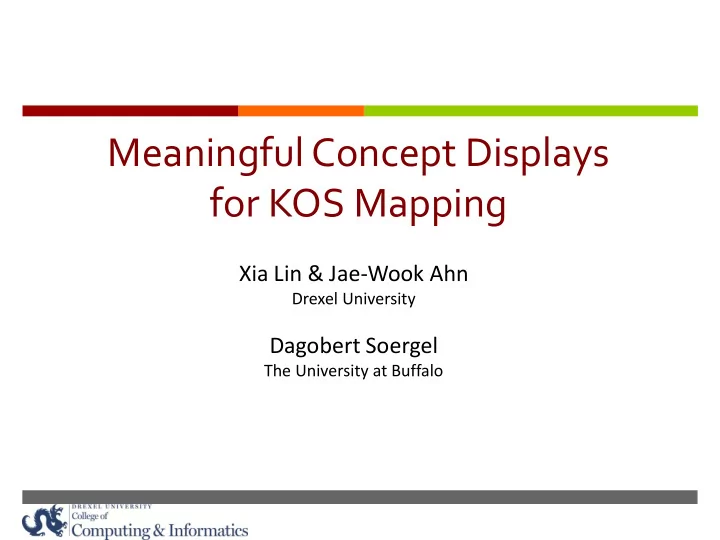

Meaningful Concept Displays for KOS Mapping Xia Lin & Jae-Wook Ahn Drexel University Dagobert Soergel The University at Buffalo
KOS Mapping There are increasing numbers of KOS available through Linked Data They are all described in RDF or OWL. They may be aggregated in one single endpoint and searchable through SPARQL queries Are they linkable at the concept level? Some are controlled vocabularies, some are not Some are elemental and some are compound concepts Many concepts will have different scopes Linked data provide only a syntactical solution to KOS mapping. Much more work need to be done at the semantic level.
Old problems? New Problems? We have had many years research on Mapping free text queries to terms in controlled vocabularies Mapping from controlled vocabulary A to controlled vocabulary B ? Mapping of controlled vocabularies A and B through C Integrate multiple vocabulary resources to one (i.e., UMLS) What’s new? Networked environment -- Instant connection through URI Interactive environment – Users make selections during the mapping process Integrated environment – vocabularies are linked to their primary resources.
Old Problems? New Problems? Testing KOS mapping as “query expansion” Document Query Collections ? Mapping 1 Mapping 2 Indexing Thesaurus Vocabulary KOS 3 Mapping 2 KOS 2 KOS 4 KOS 1
New Challenges KOS mapping as “query expansion” Document Query Collections Mapping 1 KOS 3 Mapping 2 KOS 2 KOS 4 KOS 1
Real World Problems Desire: Use Getty’s AAT to search ARTstor collections Problems: ARTstor collections are NOT indexed by AAT Some are indexed by their own controlled vocabularies Some are indexed by just a list of keywords Previous approach: Search the collections directly by AAT terms Ontology annotation – attempt to automatically assign AAT terms to ARTstor collections Our approach: Map the queries to AAT terms and AAT terms to indexing terms
Mapping Strategies Decompose queries (or terms) to elementary concepts whatever possible Identify facets of the elementary concepts Map the elementary concepts to CV terms Map CV terms to indexing terms Let the users select indexing terms that match their needs Use the facets to narrow down search results
DEMO: Mapping and Search Query: “Tempera on Cardboard 19 th century Germany” Direct search get no results.
Mapping demo The user selects AAT term: “egg tempera” Which maps to ARTstor terms: • Egg tempera, gesso on wood • Egg tempera on wood • Egg tempera on canvas • Egg tempera on masonite • Egg tempera on board • Egg tempera on panel • …….
Mapping 1 Use NLP and patterns to map the query: “tempera on cardboard 19 th century Germany” Subject: “tempera on cardboard” Pattern: “painting on surface” Tempera AAT terms: Tempera, egg tempera, gom tempera, wax tempera, …. Cardboard AAT terms: ….. Date and time: “19 th century” Location: “Germany”
Mapping 2 Map all the ARTstor indexing terms to AAT terms Which is a batch processing done during the system implementation and the results are saved in the databases During the search, the results can be showed instantly The user can click on a AAT term and see the matching ARTstor terms The search engine can display search results if any of the indexing terms are selected.
Example 2: search for “China Clay” Initial query: “China Clay” -- the search is based on string matching only.
Example 2 Queries after mapping: “Wood, Kaolin; Wood, Kaolin, animal hair; Wood, Kaolin, features”
Towards Meaningful Displays
Towards Meaningful Displays
Towards Meaningful Displays
Conclusions Meaningful displays come from meaningful mapping. KOS mapping can be done at both the global level (the whole vocabulary) and the local level (individual terms) KOS mapping needs to be done interactively The algorithmic mapping results are presented through MCDs. The user interacts with MCD to get the best of the mapping results. The mapping process and the searching and browsing process should be integrated.
Recommend
More recommend